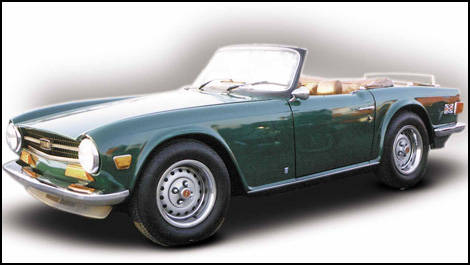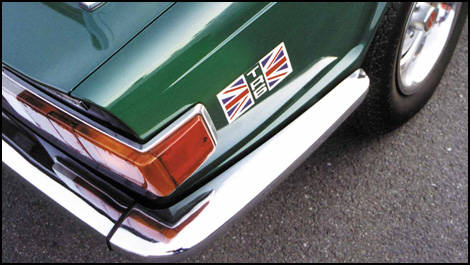The ruggedly handsome two-seater is considered the pinnacle of the Triumph line.
I don't know how the car can stand up to that kind of serious abuse," I would often say to myself.
The vehicle in question was a 1971 mustard-yellow Triumph TR6 sports car, a graduation present that my friend Gord had bought for himself. Fresh out of University and a full-fledged architect, Gord had replaced his long-since rusted out TR3, the one with the tiny doors and ill-fitting side-curtain windows, for this latest creation from the British Leyland conglomerate.
Gord loved cars, but knew nothing and cared even less about their inner workings. He simply enjoyed flogging the heck out of them at every opportunity, and his latest prize was no exception. His favourite attention-getting tactic was to bomb around town with the top down, wearing a rooster-shaped cap he had acquired from some frat house halloween party. The effect was startling, if not a bit disturbing, but Gord, a full-blown eccentric in his own right, cared little about what others thought. He was having a good time, and got a kick out of the "Chicken Man" title his friends bestowed upon him.
Fortunately, the sturdy new TR6 was up to Gord's heavy-handed driving style, at least for the first few years of ownership.
The TR6 was first launched in 1969 to rave reviews. It had been preceded by the short-lived TR5 and TR250 models that introduced six-cylinder power to the TR-series for the first time. The TR6's inline 2.5-litre pushrod (cam-in-block) motor was basically a carry-over from the TR250, as were most of its mechanical bits. However the bodywork had been restyled by Karmann, the same company that had designed the Volkswagen Karmann Ghia and built the Beetle convertible.
The major cosmetic changes consisted of moving the headlights out to the edge of each fender, and creating a chopped-off, or "Kamm-style" rear end. The result was a whole new lean and mean image for the Triumph, which proved popular with buyers, particularly in North America where 90 percent of the TR6's 94,619 total production were shipped (including every car manufactured after 1974).
I don't know how the car can stand up to that kind of serious abuse," I would often say to myself.
The vehicle in question was a 1971 mustard-yellow Triumph TR6 sports car, a graduation present that my friend Gord had bought for himself. Fresh out of University and a full-fledged architect, Gord had replaced his long-since rusted out TR3, the one with the tiny doors and ill-fitting side-curtain windows, for this latest creation from the British Leyland conglomerate.
 |
Gord loved cars, but knew nothing and cared even less about their inner workings. He simply enjoyed flogging the heck out of them at every opportunity, and his latest prize was no exception. His favourite attention-getting tactic was to bomb around town with the top down, wearing a rooster-shaped cap he had acquired from some frat house halloween party. The effect was startling, if not a bit disturbing, but Gord, a full-blown eccentric in his own right, cared little about what others thought. He was having a good time, and got a kick out of the "Chicken Man" title his friends bestowed upon him.
Fortunately, the sturdy new TR6 was up to Gord's heavy-handed driving style, at least for the first few years of ownership.
The TR6 was first launched in 1969 to rave reviews. It had been preceded by the short-lived TR5 and TR250 models that introduced six-cylinder power to the TR-series for the first time. The TR6's inline 2.5-litre pushrod (cam-in-block) motor was basically a carry-over from the TR250, as were most of its mechanical bits. However the bodywork had been restyled by Karmann, the same company that had designed the Volkswagen Karmann Ghia and built the Beetle convertible.
The major cosmetic changes consisted of moving the headlights out to the edge of each fender, and creating a chopped-off, or "Kamm-style" rear end. The result was a whole new lean and mean image for the Triumph, which proved popular with buyers, particularly in North America where 90 percent of the TR6's 94,619 total production were shipped (including every car manufactured after 1974).
 |


